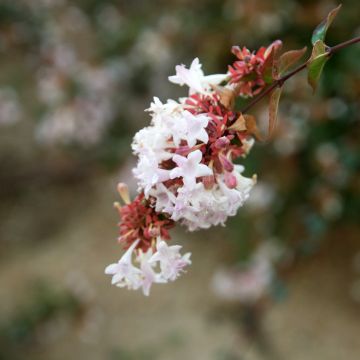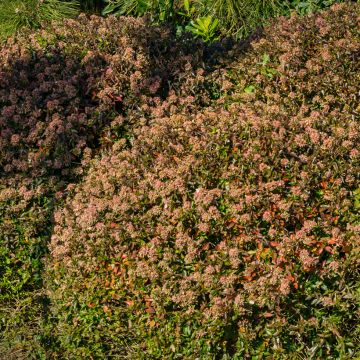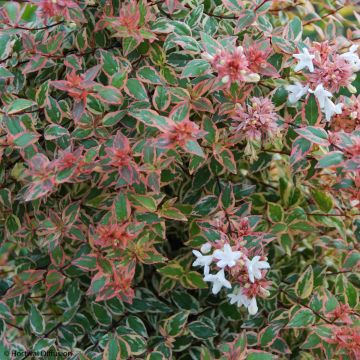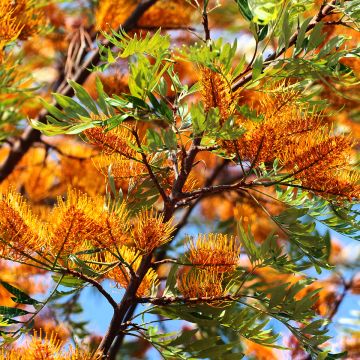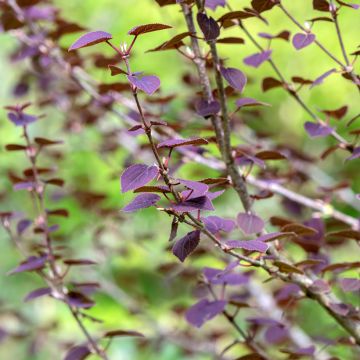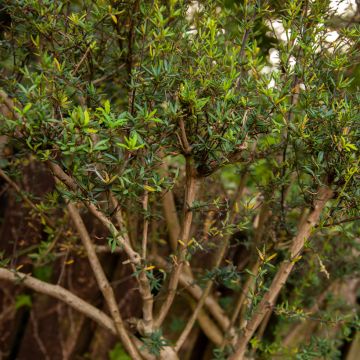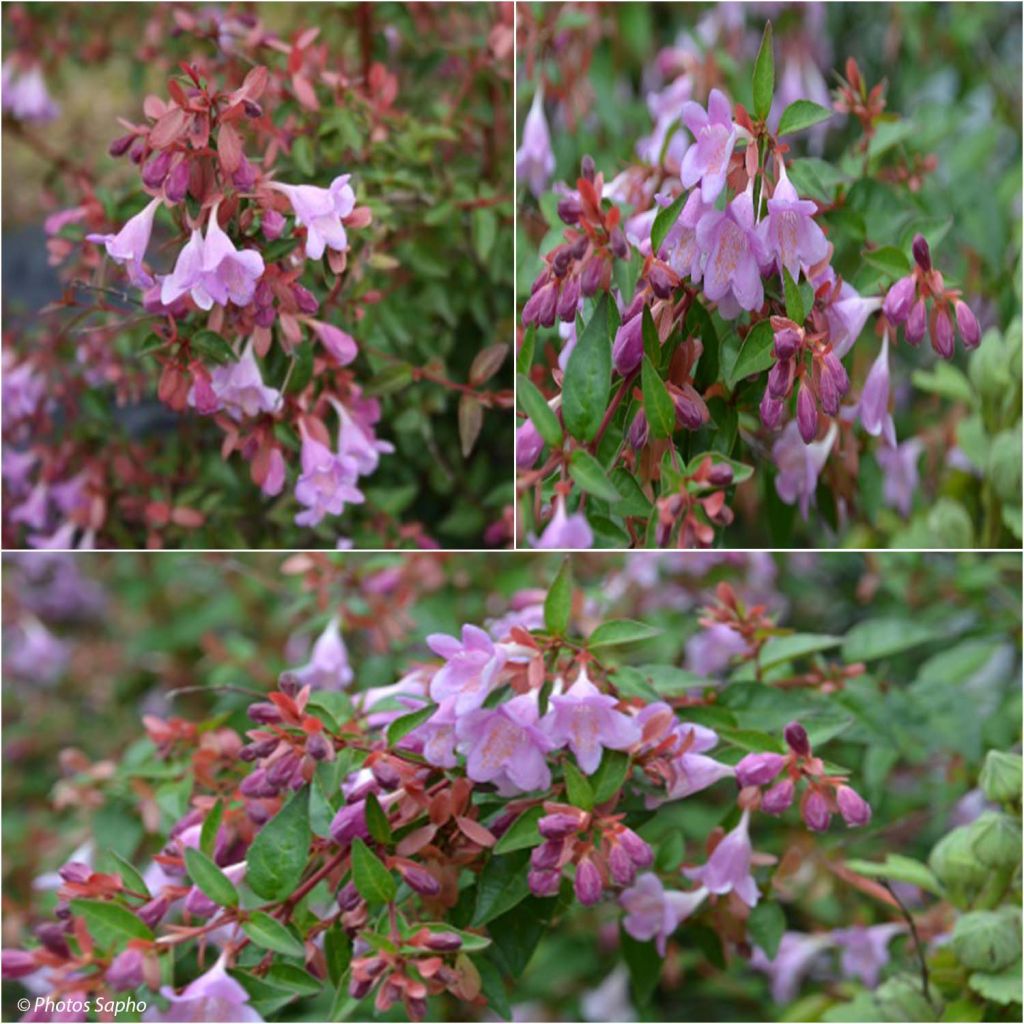

Abelia grandiflora Pink Pong
Abelia grandiflora Pink Pong
Abelia x grandiflora Pink Pong® ('ABENOV41')
Glossy Abelia
Why not try an alternative variety in stock?
View all →This plant carries a 24 months recovery warranty
More information
We guarantee the quality of our plants for a full growing cycle, and will replace at our expense any plant that fails to recover under normal climatic and planting conditions.
From €5.90 for pickup delivery and €6.90 for home delivery
Express home delivery from €8.90.
From €5.90 for pickup delivery and €6.90 for home delivery
Express home delivery from €8.90.
Does this plant fit my garden?
Set up your Plantfit profile →
Description
Abelia x grandiflora Pink Pong ('ABENOV41') is a beautiful new addition to the range of flowering and easy-to-grow bushes in gardens. It stands out for the duration and beauty of its flowering, consisting of violet-pink flowers of a good size for an abelia. Autumn paints its foliage with rich bronze shades and crowns its branches with pretty rust-coloured bracts that persist for a long time. Hardy, evergreen, and beautifully coloured from May to October, this undemanding medium-sized bush will find its place in a trimmed or untrimmed hedge, planted as a standalone, or in a mixed bed. It is a great choice for a small-sized garden.
Abelia x grandiflora Pink Pong ('ABENOV41') is a French creation (INRA/SAPHINOV) from 2014. This bush belongs to the Caprifoliaceae family and comes from Abelia x grandiflora, a vigorous, undemanding, and hardy species. With a moderately fast growth, Pink Pong® will reach on average 1.6 m (5.2 ft) in height and 1.35 m (4.4 ft) in width. Its habit is bushy and dense. This abelia offers an early and prolonged, slightly fragrant, flowering, that renews itself from May to September-October. Its countless funnel-shaped corollas, 3 cm (1.2 in) wide, ranging from violet-pink to tender lilac, sprinkled with yellow-orange at the throat, are gathered in small terminal clusters. As the flowers fade, they give way to pretty compound calyxes of rust-coloured bracts, which is very decorative on the autumn foliage. The slender and arching branches of the abelia bear glossy foliage of light green colour until summer. Under the effect of the first cool nights, the foliage takes on a more or less bronzed hue and persists for a long time on the branch. This variety retains its foliage in winter, except in the case of severe winters. A well-established bush will withstand short frosts of around -15° C (5° F), if the soil it is planted in is not waterlogged in winter.
This medium-sized abelia is suitable for planting both in groups with other bushes and alone. It also suits planting in a flowering hedge, either free or trimmed. It can be paired with companions such as Kolkwitzia amabilis 'Pink Cloud', Deutzia, Syringa microphylla 'Superba', botanical or shrub roses, Lonicera fragrantissima, a purple Berberis, or even Buddleia alternifolia 'Argentea', among many others. It is perfectly possible to plant it in a container on a terrace or balcony where it can live for many years.
Report an error about the product description
Plant habit
Flowering
Foliage
Botanical data
Abelia
x grandiflora
Pink Pong® ('ABENOV41')
Caprifoliaceae
Glossy Abelia
Cultivar or hybrid
Other Abelia
Planting and care
This abelia thrives in sunny or partially shaded areas, in most of our regions. Its hardiness is good. Once well established, it can withstand short frosts of about -15° C (5° F), in well-drained soil (without excessive moisture in winter) and sheltered from cold winds. Plant it in spring in cold regions, or in early autumn elsewhere, in a light, rather fertile, and well-drained soil. Ideally, plant it in a balanced mixture of compost and garden soil. If your soil is very heavy and compact, plant it in a slightly elevated area or add gravel to the planting hole, which should be deep (50 cm (19 in)). Easy to grow, it requires little maintenance and tolerates most soils, whether they are limestone, neutral, or slightly acidic. This plant is resistant to summer drought once established (after 2 or 3 years), salt spray, and winds, but protect it from severe frosts and cold, dry winds when young in winter. Between February and April, before the new growth starts, prune any diseased or dead wood and only keep the vigorous branches to maintain the bush's compact habit. It is not susceptible to parasites or predators.
Planting period
Intended location
Care
-
, onOrder confirmed
Reply from on Promesse de fleurs
Hedge shrubs
Haven't found what you were looking for?
Hardiness is the lowest winter temperature a plant can endure without suffering serious damage or even dying. However, hardiness is affected by location (a sheltered area, such as a patio), protection (winter cover) and soil type (hardiness is improved by well-drained soil).

Photo Sharing Terms & Conditions
In order to encourage gardeners to interact and share their experiences, Promesse de fleurs offers various media enabling content to be uploaded onto its Site - in particular via the ‘Photo sharing’ module.
The User agrees to refrain from:
- Posting any content that is illegal, prejudicial, insulting, racist, inciteful to hatred, revisionist, contrary to public decency, that infringes on privacy or on the privacy rights of third parties, in particular the publicity rights of persons and goods, intellectual property rights, or the right to privacy.
- Submitting content on behalf of a third party;
- Impersonate the identity of a third party and/or publish any personal information about a third party;
In general, the User undertakes to refrain from any unethical behaviour.
All Content (in particular text, comments, files, images, photos, videos, creative works, etc.), which may be subject to property or intellectual property rights, image or other private rights, shall remain the property of the User, subject to the limited rights granted by the terms of the licence granted by Promesse de fleurs as stated below. Users are at liberty to publish or not to publish such Content on the Site, notably via the ‘Photo Sharing’ facility, and accept that this Content shall be made public and freely accessible, notably on the Internet.
Users further acknowledge, undertake to have ,and guarantee that they hold all necessary rights and permissions to publish such material on the Site, in particular with regard to the legislation in force pertaining to any privacy, property, intellectual property, image, or contractual rights, or rights of any other nature. By publishing such Content on the Site, Users acknowledge accepting full liability as publishers of the Content within the meaning of the law, and grant Promesse de fleurs, free of charge, an inclusive, worldwide licence for the said Content for the entire duration of its publication, including all reproduction, representation, up/downloading, displaying, performing, transmission, and storage rights.
Users also grant permission for their name to be linked to the Content and accept that this link may not always be made available.
By engaging in posting material, Users consent to their Content becoming automatically accessible on the Internet, in particular on other sites and/or blogs and/or web pages of the Promesse de fleurs site, including in particular social pages and the Promesse de fleurs catalogue.
Users may secure the removal of entrusted content free of charge by issuing a simple request via our contact form.
The flowering period indicated on our website applies to countries and regions located in USDA zone 8 (France, the United Kingdom, Ireland, the Netherlands, etc.)
It will vary according to where you live:
- In zones 9 to 10 (Italy, Spain, Greece, etc.), flowering will occur about 2 to 4 weeks earlier.
- In zones 6 to 7 (Germany, Poland, Slovenia, and lower mountainous regions), flowering will be delayed by 2 to 3 weeks.
- In zone 5 (Central Europe, Scandinavia), blooming will be delayed by 3 to 5 weeks.
In temperate climates, pruning of spring-flowering shrubs (forsythia, spireas, etc.) should be done just after flowering.
Pruning of summer-flowering shrubs (Indian Lilac, Perovskia, etc.) can be done in winter or spring.
In cold regions as well as with frost-sensitive plants, avoid pruning too early when severe frosts may still occur.
The planting period indicated on our website applies to countries and regions located in USDA zone 8 (France, United Kingdom, Ireland, Netherlands).
It will vary according to where you live:
- In Mediterranean zones (Marseille, Madrid, Milan, etc.), autumn and winter are the best planting periods.
- In continental zones (Strasbourg, Munich, Vienna, etc.), delay planting by 2 to 3 weeks in spring and bring it forward by 2 to 4 weeks in autumn.
- In mountainous regions (the Alps, Pyrenees, Carpathians, etc.), it is best to plant in late spring (May-June) or late summer (August-September).
The harvesting period indicated on our website applies to countries and regions in USDA zone 8 (France, England, Ireland, the Netherlands).
In colder areas (Scandinavia, Poland, Austria...) fruit and vegetable harvests are likely to be delayed by 3-4 weeks.
In warmer areas (Italy, Spain, Greece, etc.), harvesting will probably take place earlier, depending on weather conditions.
The sowing periods indicated on our website apply to countries and regions within USDA Zone 8 (France, UK, Ireland, Netherlands).
In colder areas (Scandinavia, Poland, Austria...), delay any outdoor sowing by 3-4 weeks, or sow under glass.
In warmer climes (Italy, Spain, Greece, etc.), bring outdoor sowing forward by a few weeks.







































